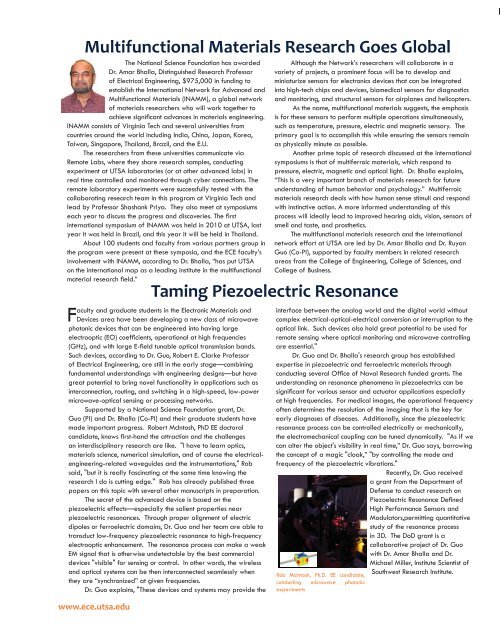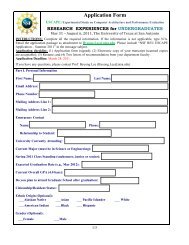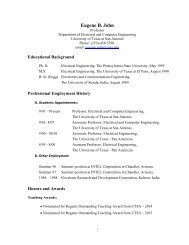ECE Elements Newsletter 2012 - Electrical and Computer ...
ECE Elements Newsletter 2012 - Electrical and Computer ...
ECE Elements Newsletter 2012 - Electrical and Computer ...
Create successful ePaper yourself
Turn your PDF publications into a flip-book with our unique Google optimized e-Paper software.
Multifunctional Materials Research Goes GlobalThe National Science Foundation has awardedof <strong>Electrical</strong> Engineering, $975,000 in funding toestablish the International Network for Advanced <strong>and</strong>Multifunctional Materials (INAMM), a global networkof materials researchers who will work together toINAMM consists of Virginia Tech <strong>and</strong> several universities fromcountries around the world including India, China, Japan, Korea,The researchers from these universities communicate viaRemote Labs, where they share research samples, conductingexperiment at UTSA laboratories (or at other advanced labs) inreal time controlled <strong>and</strong> monitored through cyber connections. Theremote laboratory experiments were successfully tested with thecollaborating research team in this program at Virginia Tech <strong>and</strong>lead by Professor Shashank Priya. They also meet at symposiumsinternational symposium of INAMM was held in 2010 at UTSA, lastAbout 100 students <strong>and</strong> faculty from various partners group inthe program were present at these symposia, <strong>and</strong> the <strong>ECE</strong> faculty’son the international map as a leading institute in the multifunctionalwww.ece.utsa.eduAlthough the Network’s researchers will collaborate in avariety of projects, a prominent focus will be to develop <strong>and</strong>miniaturize sensors for electronics devices that can be integratedinto high-tech chips <strong>and</strong> devices, biomedical sensors for diagnostics<strong>and</strong> monitoring, <strong>and</strong> structural sensors for airplanes <strong>and</strong> helicopters.As the name, multifunctional materials suggests, the emphasisis for these sensors to perform multiple operations simultaneously,such as temperature, pressure, electric <strong>and</strong> magnetic sensory. Theprimary goal is to accomplish this while ensuring the sensors remainas physically minute as possible.Another prime topic of research discussed at the internationalsymposiums is that of multiferroic materials, which respond to“This is a very important branch of materials research for futureunderst<strong>and</strong>ing of human behavior <strong>and</strong> psychology.” Multiferroicmaterials research deals with how human sense stimuli <strong>and</strong> respondwith instinctive action. A more informed underst<strong>and</strong>ing of thisprocess will ideally lead to improved hearing aids, vision, sensors ofsmell <strong>and</strong> taste, <strong>and</strong> prosthetics.The multifunctional materials research <strong>and</strong> the internationalGuo (Co-PI), supported by faculty members in related researchareas from the College of Engineering, College of Sciences, <strong>and</strong>Taming Piezoelectric ResonanceFaculty <strong>and</strong> graduate students in the Electronic Materials <strong>and</strong>Devices area have been developing a new class of microwavephotonic devices that can be engineered into having largeSuch devices, according to Dr. Guo, Robert E. Clarke Professorof <strong>Electrical</strong> Engineering, are still in the early stage—combiningfundamental underst<strong>and</strong>ings with engineering designs—but havegreat potential to bring novel functionality in applications such asinterconnection, routing, <strong>and</strong> switching in a high-speed, low-powermicrowave-optical sensing or processing networks.Supported by a National Science Foundation grant, Dr.made important progress. Robert McIntosh, PhD EE doctoralan interdisciplinary research are like. "I have to learn optics,materials science, numerical simulation, <strong>and</strong> of course the electricalengineering-relatedwaveguides <strong>and</strong> the instrumentations," Robsaid, "but it is really fascinating at the same time knowing theresearch I do is cutting edge." Rob has already published threepapers on this topic with several other manuscripts in preparation.The secret of the advanced device is based on thepiezoelectric effects—especially the salient properties nearpiezoelectric resonances. Through proper alignment of electricdipoles or ferroelectric domains, Dr. Guo <strong>and</strong> her team are able totransduct low-frequency piezoelectric resonance to high-frequencyelectrooptic enhancement. The resonance process can make a weakEM signal that is otherwise undetectable by the best commercialdevices "visible" for sensing or control. In other words, the wireless<strong>and</strong> optical systems can be then interconnected seamlessly whenthey are “synchronized” at given frequencies.Dr. Guo explains, "These devices <strong>and</strong> systems may provide theinterface between the analog world <strong>and</strong> the digital world withoutcomplex electrical-optical-electrical conversion or interruption to theoptical link. Such devices also hold great potential to be used forremote sensing where optical monitoring <strong>and</strong> microwave controllingare essential."expertise in piezoelectric <strong>and</strong> ferroelectric materials throughunderst<strong>and</strong>ing on resonance phenomena in piezoelectrics can beat high frequencies. For medical images, the operational frequencyoften determines the resolution of the imaging that is the key forearly diagnoses of diseases. Additionally, since the piezoelectricresonance process can be controlled electrically or mechanically,the electromechanical coupling can be tuned dynamically. "As if wecan alter the object's visibility in real time,” Dr. Guo says, borrowingthe concept of a magic "cloak,” "by controlling the mode <strong>and</strong>frequency of the piezoelectric vibrations."Recently, Dr. Guo receiveda grant from the Department ofDefense to conduct research onHigh Performance Sensors <strong>and</strong>Modulators,permitting quantitativestudy of the resonance processin 3D. The DoD grant is acollaborative project of Dr. GuoMichael Miller, Institute Scientist ofSouthwest Research Institute.Rob McIntosh, Ph.D. EE c<strong>and</strong>idate,conducting microwave photonicexperiments






